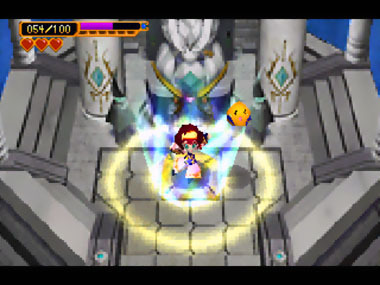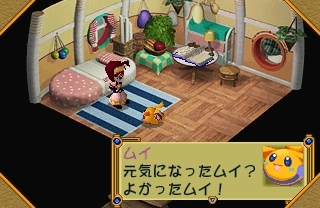|
|

|
PLATFORM
|
PSX
|
BATTLE SYSTEM
|

|
INTERACTION
|

|
ORIGINALITY
|

|
STORY
|

|
MUSIC & SOUND
|

|
VISUALS
|

|
CHALLENGE
|
Moderate
|
LANGUAGE BARRIER
|
Moderate
|
COMPLETION TIME
|
Less than 20 Hours
|
|
OVERALL

|
+ Setting is bizarrely original.
+ Some amazing CGI sequences.
+ Fun premise.
- Dungeon designs are just boring.
- There are some logistical issues.
- No grace period after taking hits.
|
Click here for scoring definitions
|
|
|
I found Purumui Purumui in a local bargain bin a few months back. The case showed off the game's colorful art design, which is how it caught my eye. The blurbs on the case described it as a "Morphing RPG." As it turned out, this meant the game played like a cross between the original Legend of Zelda and A Boy and His Blob.
The world of Fillip Side is an odd one. For starters, it's flat and populated with an oddball assortment of Jim Henson rejects. One of the locals is Mui, a bouncy little slime-like thing that can morph his body into various shapes. One day, he and his sister Puri witness the arrival of Madoka, a red-haired stranger whose origins are obscure even to herself. While the story beyond this point (in the opening credits) isn't very well presented, it certainly is creative. An evil warlord, imprisoned in cryostasis for a thousand years, has managed to free himself just enough to access the control systems of his superweapon, the Dread Naught. Fillip Side just happens to rest on top of the Dread Naught's containment facility. To access the control center, Madoka and Mui must find the five Power Medals that act as keys, defeat the warlord's ditzy lackey Shaina, and find out what happened to Mui's little sister, who gets kidnapped early on.
As stated before, however, the story's presentation is lacking. Much of it comes at the player in short bursts of infocram after each major dungeon. Madoka and Shaina don't actually meet until their big final showdown, even though Shaina is directly responsible for every hurdle and barrier to progress in the game. Most of Fillip Side's Muppet-esque population just happens to live there with only a few serving any importance to the plot. After each major dungeon is completed, the Mother Goddess will appear to give Madoka a new goal, and Mui's grandfather will help point the way. Without fail, Shaina will have done something to block access to the dungeon, so a minor dungeon must be explored to find the means (or the means to find the means) to get in. Wince and repeat.
The key to getting anywhere on Fillip Side is Mui's shapechanging power. When provided with the right snack, his body will warp and expand into all sorts of shapes. Some forms and foods, such as bridges (shortcake) or ladders (churros) will be relevant throughout the game, but others are only used to access a level. About half the snacks just restore hit points or star points. Even when a dungeon offers the opportunity to use a particular form, such as points where Mui's grappling hook form can be used to make a shortcut, limited space in Madoka's picnic basket means that healing items and necessary transit snacks take precedence over everything else. Added to this is the effort needed to keep enough ingredients in stock. While many ingredients may be bought in stores, cash can be hard to come by. It is usually more cost-effective to harvest things personally at various points on the map, though this is more time-consuming. The player can expect to spend a lot of time running around just to get supplied properly.
 I dub thee Slime!
I dub thee Slime!
|
|
Of all the morphing items, the only ones that are not consumable are the Power Medals. These become active upon entering a dungeon, and transform Mui into a variety of job classes. When a medal is active, Madoka can charge up Mui to attack enemies from a distance. This may also have other effects, like the Mage class fire attack that can hit across the room or the Druid class attack that can freeze enemies. A press of the R1 button will either create a power suit for Madoka or summon an entity to attack, depending on the medal. R1 abilities take a good chunk out of Madoka's star points, but can also be a lifesaver in tough situations. Also, Madoka can duck attacks with the B button, though this can be difficult to time properly.
For all that they are the central focus of the game, the dungeons come off as being poorly designed -- long sets of boxy rooms in various combinations. The best comparison really would be to the original Legend of Zelda, as doors are always at the cardinal points, rooms are the same size 99% of the time, and the monster selection is both limited and heavily palette swapped. There are hazards aplenty, most of which can also damage enemies. Unfortunately, when Madoka is knocked back by an attack, there is no grace period before she can take damage again. Instead, prolonged contact with an enemy means constant damage and repeated knockbacks. Even late in the game it's possible for weak enemies to push her back into a corner or hazard and take a big chunk of health before she has a chance to retaliate. While enemies drop cash with regularity, there are no similar health item drops to help keep Madoka going.
Purumui certainly paints a pretty picture, at least. While the majority of character models are polygonal and blocky, the non-dungeon environments are as detailed as they are quirky. At major plot points and before big bosses, the player is treated to some surprisingly high quality CGI sequences. The game isn't nearly so successful on the auditory front, but it's hard to complain as the music fits the overall game well. It's just not remarkable on its own.
 Can you morph into a pillow, please?
Can you morph into a pillow, please?
|
|
This isn't a particularly text-heavy title, but the need to crisscross the map to find particular NPCs or materials can make it difficult to advance the game at times without guidance. The bare-bones storytelling means that players will have trouble understanding what it is that they're supposed to do, or why they're doing it.
There is one good reason to finish this game though, and that's the omake, or extra material, that becomes available at the end. Following the final credits is a full eight minutes of television-style animation which might be of a prequel or alternative version of the events in the game. It certainly differs from the actual game content in most every respect. Still, it is impressive enough to make me glad I finished the game. I just wish Purumui had been good enough to stand on all its merits.
Review Archives
|









